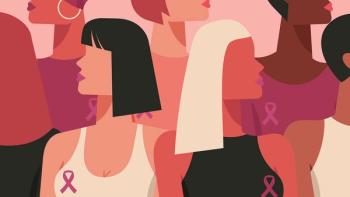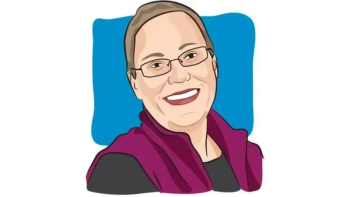
End-of-Life Care Is Suboptimal in Elderly Patients With AML
End-of-life care is of particular concern for elderly patients with AML because prognosis is poor and has not changed in several decades. Median survival for patients 65 or older is roughly two months and drops to as low as one month for patients over 85 years.
Rong Wang, Ph.D.
For elderly patients with acute myeloid leukemia (AML), hospice enrollment is low and the number of patients being treated with aggressive treatment is high. This situation, which researchers refer to as “suboptimal” was examined in a study recently published in the Journal of Clinical Oncology
Among the 5,847 patients in the study who enrolled in hospice, 47.4 percent did so within the final seven days of life and 28.8 percent did so within three days of dying. The investigative team, led by Rong Wang, Ph.D., a research scientist with Yale University’s COPPER Center, found that the percentage of patients entering hospice steadily increased from 1999 to 2012, but that was largely due to patients enrolling within seven days of death.
End-of-life care is of particular concern for elderly patients with AML because prognosis is poor and has not changed in several decades. Median survival for patients 65 or older is roughly two months and drops to as low as one month for patients over 85 years.
Investigators conducted a population-based, retrospective cohort study based on data from 13,156 patients aged 65 years or older who were diagnosed with AML from 1999 to 2011 and died before Dec. 31, 2012. They used Medicare claims to assess patterns of hospice care and use of aggressive treatment.
“Our findings suggest that hospice is not being used optimally to provide end-of-life care for older patients with AML,” wrote Wang et al. “Unrealistic expectations of patients, families, and physicians have been cited as factors contributing to the underuse of hospice in patients with AML, but the current hospice model itself may not be well suited to handle the rapid clinical decline and medical complications commonly experienced by older patients with AML approaching the end of life. The increased overall use of hospice with concomitant increase in the proportion admitted within seven days of death raises the question of whether patients are simply being admitted to hospice to manage death rather than obtaining the benefits of symptom management and palliative support that hospice can provide.”
Wang et al suggested that cytopenia might be an obstacle to getting these patients enrolled in hospice earlier. Transfusion is an important part of supportive care for patients with AML, but a national survey of 591 hospices showed that 40 percent of hospices did not admit patients with transfusion needs, and Wang et al noted that some patients left hospice then received treatment, usually transfusion support rather than chemotherapy.
“Although many hematologic oncologists acknowledged the importance of hospice care, the lack of availability of transfusions in the hospice setting is an important concern for hospice referral. Taken together, the transfusion needs of patients with AML may constitute a barrier to timely hospice enrollment and prompt hospice disenrollment,” the investigators wrote. “Alternative policies allowing the provision of transfusion in hospice care may better meet the specific needs of older patients with AML, and possibly other patients who may benefit from transfusion near the end of their life. Under current circumstance, physicians likely consider a patient’s need of transfusion when discussing or recommending hospice enrollment.”
Men and nonwhite patients were less likely to enroll in hospice, which is consistent with recognized sex and racial disparities in end-of-life care. Investigators said physician and patient education and expanded use of culturally sensitive end-of-life care may help address those disparities.
Patients with longer survival (30 days or more) were more likely to enroll in hospice (48.1 percent vs 30.7 percent). Among those enrolled in hospice, nearly half (51.2 percent) of patients who died within 30 days of starting their first stay in hospice enrolled in the last three days of life, compared with only 24.9 percent of patients who survived longer.
Wang et al found that use of chemotherapy in the final 14 days of life became more common over time, increasing from 7.7 percent in 1999 to 18.8 percent by 2012. Patients who received chemotherapy within the last 14 days of life were more likely to have ICU care in the last 30 days of life (43.0 percent vs 28.4 percent) but less likely to enroll in hospice (22.1 percent vs 47.4 percent) compared with patients who did not undergo such aggressive treatment.
Multivariate analysis showed that men, married people, and patients who died more recently were more likely to receive chemotherapy in the final two weeks of life. Older patients, those who had state Medicaid buy-in, those who lived outside the Northeast, and those who lived outside of major metropolitan areas were less likely to receive late chemotherapy.
Gregory Abel, M.D., director of the Older Adult Hematologic Malignancy Program at Dana-Farber Cancer Institute, recorded a podcast offering expert opinion on the findings from Wang et al.
Whether measures such as timely hospice enrollment are the proper metric to assess end-of-life care for older patients with AML is an open question because they were initially designed for patients with solid tumors and later adapted for patients with hematologic malignancies, Abel said. Nonetheless, the research suggests that this patient population has not been fully served by the current practice in end-of-life care.
“For now, these are the metrics we have for older patients with AML,” said Abel. “In that context, the current analysis suggests we need to do a better job caring for these patients when they are near death.”





